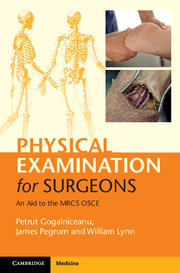Book contents
- Frontmatter
- Dedication
- Contents
- List of contributors
- Introduction
- Acknowledgments
- List of abbreviations
- Section 1 Principles of surgery
- Section 2 General surgery
- Section 3 Breast surgery
- Section 4 Pelvis and perineum
- Section 5 Orthopaedic surgery
- Section 6 Vascular surgery
- Section 7 Heart and thorax
- Section 8 Head and neck surgery
- Section 9 Neurosurgery
- Section 10 Plastic surgery
- Section 11 Surgical radiology
- Section 12 Airway, trauma and critical care
- 63 Examination of the trauma patient
- 64 Examination of the critically ill surgical patient
- 65 Assessment of the airway for intubation
- 66 Assessment of the compromised airway
- 67 Examination of a tracheostomy
- Index
67 - Examination of a tracheostomy
from Section 12 - Airway, trauma and critical care
Published online by Cambridge University Press: 05 July 2015
- Frontmatter
- Dedication
- Contents
- List of contributors
- Introduction
- Acknowledgments
- List of abbreviations
- Section 1 Principles of surgery
- Section 2 General surgery
- Section 3 Breast surgery
- Section 4 Pelvis and perineum
- Section 5 Orthopaedic surgery
- Section 6 Vascular surgery
- Section 7 Heart and thorax
- Section 8 Head and neck surgery
- Section 9 Neurosurgery
- Section 10 Plastic surgery
- Section 11 Surgical radiology
- Section 12 Airway, trauma and critical care
- 63 Examination of the trauma patient
- 64 Examination of the critically ill surgical patient
- 65 Assessment of the airway for intubation
- 66 Assessment of the compromised airway
- 67 Examination of a tracheostomy
- Index
Summary
Checklist
WIPER
• Gloves/eye protection if handling the airway
Physiological parameters
Look
• Agitation
• Cyanosis/desaturation
• Respiratory rate
• Tube position
• Chest movement
Listen
• Air entry into chest
• Air leak around cuff
Feel
• Surgical emphysema
• Suction catheter passage
Examination notes
What do you look for in the initial observation of a tracheostomy?
• See-sawing chest movements are a sign of airway obstruction.
• Agitation, hypertension and tachycardia may be the first indicators that there could be a problem with the tracheostomy.
• Cyanosis and desaturation are late signs, and should not be relied on as the sole means of indicating a problem.
• Examine the tracheostomy tubing more carefully: most of the tube should be within the trachea via the stoma.
What are the various types of tracheostomy?
There are two ways of performing a tracheostomy:
Percutaneous – performed in ITU by intensivists/anaesthetists using the Seldinger technique with progressive dilatation over a guidewire.
Surgical – performed in the operating theatre under direct vision.
How do you assess whether a tracheostomy has become misplaced?
Observe the patient and auscultate the chest to hear any signs of air entry. If there is a leak around the tracheostomy cuff or stoma then this would normally be heard as a ‘gurgling’ sound or slow release of air when applying positive-pressure ventilation. If there is no air entry into the chest you should suspect that the tracheostomy has become displaced.
- Type
- Chapter
- Information
- Physical Examination for SurgeonsAn Aid to the MRCS OSCE, pp. 497 - 498Publisher: Cambridge University PressPrint publication year: 2015



